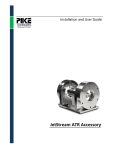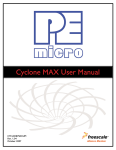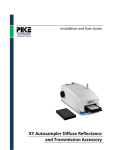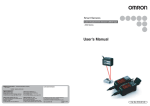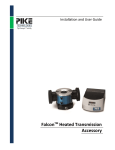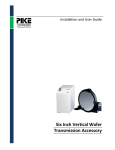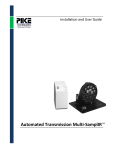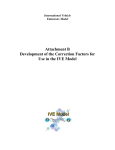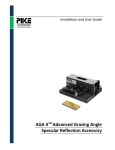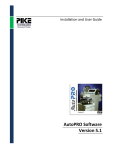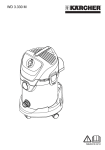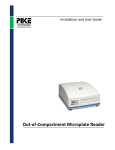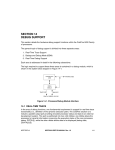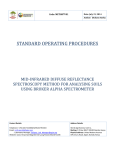Download HATR Flow-Through Cell
Transcript
Installation and User Guide HATR Flow Cell, Jacketed Flow Cell, Heated Flow Cell for Horizontal ATR Accessories The information in this publication is provided for reference only. All information contained in this publication is believed to be correct and complete. PIKE Technologies, Inc. shall not be liable for errors contained herein nor for incidental or consequential damages in connection with the furnishing, performance, or use of this material. All product specifications, as well as the information contained in this publication, are subject to change without notice. This publication may contain or reference information and products protected by copyrights or patents and does not convey any license under the patent rights of PIKE Technologies, Inc. nor the rights of others. PIKE Technologies, Inc. does not assume any liability arising out of any infringements of patents or other rights of third parties. This document contains confidential or proprietary information of PIKE Technologies, Inc. Neither this document nor the information herein is to be reproduced, distributed, used or disclosed, either in whole or in part, except as specifically authorized by PIKE Technologies, Inc. PIKE Technologies, Inc. makes no warranty of any kind with regard to this material including, but not limited to, the implied warranties of merchantability and fitness for a particular purpose. Copyright 1991-2015 by PIKE Technologies, Inc., Madison, WI 53719. Printed in the United States of America. All world rights reserved. No part of this publication may be stored in a retrieval system, transmitted, or reproduced in any way, including but not limited to, photocopy, photograph, magnetic or other record, without the prior written permission of PIKE Technologies, Inc. Address Comments to: PIKE Technologies, Inc. 6125 Cottonwood Drive Madison, WI 53719 Phone Fax E-mail Web Site Jan. 1, 2015 (608) 274-2721 (608) 274-0103 [email protected] www.piketech.com Contents Introduction Optical Diagram Unpacking Your Accessory Packing List Installation Performance Verification Sampling Procedures Cell Filling Cell Cleaning Liquid Jacketed Flow-Through Cell Heated Flow-Through Cell Temperature Controller ATR Spectra ATR Correction Liquids Theory How ATR Works Depth of Penetration Number of Reflections Materials Zinc Selenide Germanium Silicon KRS-5 Precautions Mirrors SAFETY Replacement Parts and Options Refurbished Parts Removing an HATR Flow Cell Crystal Installing a Crystal 1 1 2 2 3 4 5 5 6 7 8 8 9 10 11 12 12 12 13 14 14 14 14 14 15 15 15 16 16 17 19 Introduction The PIKE Technologies Horizontal ATR (HATR) is an economical high throughput ATR accessory designed for use in your FTIR spectrometer. The compact design employs a pair of transfer optics to direct the infrared beam to one end of an IR transmitting ATR crystal. A similar pair of optics directs the beam emitted from the other end of the ATR crystal to the spectrometer detector. The HATR can fit the Flow-Through Liquid Cell and the Heated Liquid Cell. The accessory is also available with two other basic types of mounted crystal, the trough plate for the analysis of liquids and pastes, and the flat plate for the analysis of pliable solid films. The most common material used for the prism is zinc selenide. Other materials are available and are described later in this manual. The standard ATR crystal for the liquid flow-through cell is of a trapezoid shape and is 80 mm long, 10 mm wide and 4 mm thick resulting in 10 reflections for 45° crystals and 5 reflections for 60° crystals. In order to produce optimum performance from the accessory, the thickness of the crystal has been carefully chosen. A thinner crystal would give more bounces in the crystal, resulting in a greater absorbance in the spectrum, but the overall throughput of the device would be reduced. 2 mm thick Ge and ZnSe crystals are available for applications requiring 20 reflections. Liquid IN Left Purge Tube Liquid OUT Right Purge Tube Mounting Screw HATR Base Assembly Figure 1. Sectional view of the HATR Accessory (please note that the final configuration is spectrometer dependent and may be slightly different from the picture above). The liquid cells are placed on top of the accessory and can be easily removed for cleaning or filling. PN 350-002240-05 P a g e |1 Unpacking Your Accessory In order for you to quickly verify receipt of your accessory, we have included a packing list. Please inspect the package carefully. Packing List HATR Flow-Through Cell Manual HATR Flow-Through Cell Swagelok Fittings PN 350-002240 PN 022-40XX, 022-54XX, Quantity 2 Quantity 1 or 022-52XX Quantity 1 PN 350-002240-05 P a g e |2 Installation The flow-through liquid cell should be placed on top of the HATR accessory. The cell has been aligned and tested to ensure that it performs to specification. There are no customer alignments necessary to use with a similarly pre-aligned HATR. 1. Set your FTIR spectrometer to collect data at 4 cm-1 spectral resolution (including the FTIR J-stop). 2. The HATR accessory fits into the sample compartment of the FTIR spectrometer. Your HATR is provided with the appropriate sample compartment baseplate for the model FTIR instrument you specified. Before inserting the accessory in the sample compartment, ensure that your spectrometer is aligned. If the instrument is not aligned, maximize the interferogram signal (the IR energy throughput) of your FTIR spectrometer. This should be performed by following the manufacturer’s instructions. 3. Fasten the accessory directly into the FTIR sample compartment or onto the FTIR sample compartment baseplate. In order to locate the accessory in the correct position, simply place the entire accessory into the FTIR sample compartment with the HATR label facing the front and line up the baseplate provided with the holes/pins in your model FTIR spectrometer. 4. Tighten the mounting screws to firmly position the accessory baseplate onto the FTIR sample compartment baseplate. 5. Place flow-through liquid cell on top of HATR accessory with the two pins matching the openings on the liquid cell. PN 350-002240-05 P a g e |3 Performance Verification 1. With the accessory removed from the sample compartment, collect a background spectrum. 2. Place the HATR accessory in the instrument. 3. Collect a transmission spectrum using the same collection parameters as used to collect the background spectrum. The minimum transmission value at 1000 cm-1 are shown in Table 1. If your accessory does not meet this minimum transmission value when installed, please contact PIKE Technologies. Please have the serial number of the accessory which is located on the rear of your accessory. Table 1. Transmission value for HATR accessory. Crystal Type ZnSe or Ge ZnSe or Ge ZnSe or Ge PN 350-002240-05 Crystal Thickness (mm) 4 2 4 Crystal Angle (o) Energy Throughput (%) 45 45 60 ≥ 15 ≥8 ≥8 P a g e |4 Sampling Procedures The spectrum of the required sample is obtained by ratioing a sample scan collected with a sample in the liquid cell to a background scan collected with no sample on the face of the crystal or to a background scan collected with the pure solvent or other reference material in the cell. Cell Filling It is recommended to remove the cell from the accessory base for convenient filling and emptying. One way of filling the cell is using syringes attached to the Luer lock liquid ports. The cell could be held at an angle, such that an air bubble may move up towards the outlet port. You may find it convenient to use another syringe (as shown in the picture below) to capture the overflow, especially when working with hazardous materials. Always check the sealing prior to use by filling the cell while the cell is removed from the HATR base. Gently pull plunger of receiving syringe upward to draw sample into cell. Note: With certain syringes one can exert a significant pressure. Please make sure that you are not forcing liquid through the cell, because the cell could leak and in extreme cases the crystal could break from high pressure. If the cell seems blocked, pulling the liquid with the syringe is more appropriate to clean the blockage than forcing liquid through a blocked cell. The surface of the crystal should be fully covered for proper measurements, thus make sure that the liquid flows out clearly without any bubbles indicating that the cell is full. It is recommended that the temperature difference between the sample and the crystal be not more than 30 °C. So for a crystal at room temperature, the sample may be at a temperature of up to 50 °C. Please contact PIKE Technologies if you wish to place samples of a higher temperature on the crystal PN 350-002240-05 P a g e |5 surface. Heated HATR plates are also available and can be heated up to 130 °C. After the sample has been measured, the cell needs to be flushed with the next sample until there is no residue left from the previous sample. Should the next sample be different in its chemical nature or the concentration is very different, the cell needs to be washed in between samples. Cleaning and cleaning validation is application and sample specific so the user has to make sure that there is no cross contamination from an earlier sample that could change the measurement results. Cell Cleaning Sometimes “carry over” may occur from one sample to another due to incomplete cleaning of a prior sample from the face of the crystal. This effect may be minimized by “washing” the Flow Cell with the new sample, cleaning the crystal and then running a background scan. The sample is then injected again and a sample spectrum collected. The Flow Cell can be cleaned easily by flushing the cell with an appropriate solvent, detergent or other cleaning fluids. The cell seal is Viton™ thus the solvents have to be compatible with the allowable materials that do not damage Viton™. Chemical-resistant perfluoroelastomer O-rings for the cell are also available. Samples should never be left in contact with the crystal for an extended period of time as some samples may degrade the crystal material. Once the measurement has been made, remove the sample from the crystal by cleaning the cell with a suitable solvent. Should the crystal surface inside the cell get contaminated such that it is not removable by flushing the cell, the only remedy is to take the cell apart. This has to be performed with care, because the crystal is very sensitive. Scratches on the surface of the crystal will result in a reduction in the throughput of the accessory. PN 350-002240-05 P a g e |6 The top of the cell assembly can be removed by removing the six screws holding the plate with a 3/32 hex tool. The crystal surface is now exposed and can be cleaned. A solvent (see the section below on crystal cleaning) and a “Q tip” should be used to remove traces of a previous sample. Apply the solvent to the crystal with a Q-tip and gently remove using a Q-tip or non-abrasive wipe. Repeat this procedure until all traces of the sample have been removed. The solvent used for cleaning your crystal is dependent on the sample that has been analyzed. In all cases it is best to attempt to clean the crystal with the mildest solvent possible. For most cases the preferred solvent is isopropyl alcohol. If a more vigorous solvent is required, acetone may be used. In very stubborn cases dimethylformamide (DMF) may be used. Both acetone and DMF are not compatible with Viton O-rings; therefore, the perfluoroelastomer O-rings must be used with the flow cell when cleaning with these solvents. In all cases when using solvents, inspect the materials safety data sheet associated with the solvent you are using and comply with any recommended handling procedures. Also, confirm solvent compatibility with the liquid cell O-ring. Note: Under no circumstances must the crystals be rubbed with paper products such as “Kleenex”. Many paper products are abrasive and could cause scratching of the crystal surface. Liquid Jacketed Flow-Through Cell This assembly has the same functionality as the above Flow Cell, thus all sampling, cleaning and installation instructions apply. The difference is that the top plate has sealed channels machined into the plate to allow external temperature controlled fluids to circulate through the cell body and thus control the temperature of the assembly. The temperature controlled fluid could for example come from a circulating water bath. The Liquid Jacketed Flow-Through Cell does not have any flow control devices, thus the temperature and flow control, including pumping, filtering, temperature measurement and heating or cooling the temperature control fluids is entirely provided by an external device. The recommended temperature range for this device is up to 130 °C. And the temperature control fluid should be connected to the bronze fittings on the front of the top plate (see picture above). PN 350-002240-05 P a g e |7 Heated Flow-Through Cell This assembly contains a horizontal ATR crystal mounted in a heated plate block. Two heater elements are used to heat the block to ensure even heating of the crystal and sample. The temperature of the block is monitored and controlled by an RTD (resistive temperature detector). Since the maximum temperature of the block can be 130 °C, touching the block could cause burns. The block has two high temperature epoxy, low thermal conductivity sides, which may be grasped when removing the assembly. Acetal copolymer support may also be held when removing the assembly. The input voltage is 90-264V, auto setting. The output voltage is 24VDC/50W maximum. To prevent thermal runaway due to a RTD fault combined with a temperature controller fault, the heaters have been sized such that if the output of the controller is left on continuously, the maximum temperature will not exceed 130 °C. Temperature Controller The temperature controller contains a high capability Proportional Integral Differential (PID) temperature controller. For detailed information on the programming and usage of the controller, please consult the Temperature Controller User Manual. PN 350-002240-05 P a g e |8 ATR Spectra ATR spectra are similar to transmission spectra. A careful comparison of ATR spectra and transmission spectra reveals that the intensities of the spectral features in an ATR spectrum are of lower absorbance than the corresponding features in a transmission spectrum and especially in the high wavenumber (short wavelength) region of the spectrum. The intensity of the ATR spectrum is related to the penetration depth of the evanescent wave into the sample. This depth is dependent on the refractive index of the crystal and the sample, and upon the wavelength of the IR radiation. The relatively thin depth of penetration of the IR beam into the sample creates the main benefit of ATR sampling. This is in contrast to traditional FT-IR sampling by transmission where the sample must be diluted with IR transparent salt, pressed into a pellet or pressed to a thin film, prior to analysis to prevent totally absorbing IR bands. A comparison of transmission vs. ATR sampling result for a thick polymer sample is shown below where the sample is too thick for high quality transmission analysis (shown in the lower spectrum). In transmission spectroscopy, the IR beam passes through the sample and the effective path length is determined by the thickness of the sample and its orientation to the directional plane of the IR beam. Clearly in the example below the sample is too thick for transmission analysis because most of the IR bands are totally absorbing. Figure 2. Comparison of ATR and transmission spectrum PN 350-002240-05 P a g e |9 However, simply placing the thick sample on the ATR crystal and applying pressure generates a high quality spectral result (upper red spectrum) - identified by library search as a polybutylene terephthalate. The total analysis time for the thick polymer by ATR was less than 1 minute. ATR Correction If an ATR spectrum representative of a transmission spectrum is desired, the ATR spectrum must be processed with the ATR correction program available on your instrument. An example of the effect of this correction on a spectrum is shown in the following example for polystyrene. The lower spectrum is the original ATR spectrum of polystyrene. The middle, blue spectrum is the transmission spectrum of polystyrene. Clearly the IR bands around 3000 cm-1 in the ATR spectrum are weaker relative to the IR bands at longer wavelength. Figure 3. Original and corrected spectra However, in the upper red spectrum after ATR correction, we see relative IR band intensities very similar to those from the polystyrene run by transmission. PN 350-002240-05 P a g e | 10 Liquids Two, one minute, 4 cm-1 resolution spectra of dishwashing liquids were collected using a trough plate configuration. There is an apparent difference between the purely water based and alcohol containing detergents. 100 Transmittance 90 80 70 60 1800 1600 1400 1200 Wavenumber (cm-1) 1000 800 600 Figure 4. Comparison of liquid detergents Two, one minute, 4 cm-1 spectra were collected using a trough plate crystal. The samples were a diet and regular soft drink. .12 .1 Absorbance .08 .06 .04 .02 0 1800 1600 1400 Wavenumber (cm-1) 1200 1000 Figure 5. Comparison of two soft drinks PN 350-002240-05 P a g e | 11 Theory How ATR Works With ATR sampling we direct the IR beam into a crystal of relatively higher refractive index. The IR beam reflects from the internal surface of the crystal and creates an evanescent wave, which projects orthogonally into the sample in intimate contact with the ATR crystal. Some of the energy of the evanescent wave is absorbed by the sample and the reflected radiation (some now absorbed by the sample) is returned to the detector. This ATR phenomenon is shown graphically in the following representation of a single reflection ATR. Figure 6. Graphical Representation of a Single Reflection ATR Depth of Penetration The depth of penetration gives us a relative measure of the intensity of the resulting spectrum and is expressed by the following equation: dp = λ ( 2π n12 sin 2 θ1 − n22 ) 1 2 where: λ θ n1 n2 = Wavelength of light = Angle of incidence of the IR beam = Refractive index of the crystal = Refractive index of the sample PN 350-002240-05 P a g e | 12 Below is a table giving depth of penetration in microns as a function of crystal material. The penetration depth is calculated for a sample with a refractive index of 1.40 at 1000 cm-1 with a 45° angle of incidence. Material Refr. Index Depth of Penetration (µ) ZnSe 2.4 1.66 AMTIR 2.5 1.46 Ge 4.0 0.65 Si 3.4 0.84 KRS-5 2.37 1.73 Number of Reflections The number of reflections in the crystal gives a measure of the intensity of the resulting spectrum. This number is a function of the effective angle of incidence, and the length and thickness of the crystal. For this accessory, the crystal is 4 mm thick and 80 mm long. The angle of incidence is typically 45°. Substituting these values in the equation: N= l _ 2t*tan θ Nomenclature θ = Effective angle of incidence l = Length of crystal t = Thickness of crystal Gives a value of 10 for the number of reflections. PN 350-002240-05 P a g e | 13 Materials The following HATR crystal materials are available: Material Refractive Index at 1000 cm-1 Spectral Range (cm-1) Safe pH Zinc Selenide 2.4 20000-630 5-9 AMTIR (As/Se/Ge) 2.5 11000-630 1-9 Germanium 4.0 5500-780 1-14 Silicon 3.4 8300-1500 1-12 KRS-5 2.37 17900-400 5-8 Zinc Selenide ZnSe is the preferred replacement for KRS-5 for all routine applications. Its useful spectral range is less at the low frequency end than that of KRS-5, but the mechanical strength of this rigid, hard crystalline material is superior. Although a general purpose material, it has limited use with strong acids and alkalies. The surface becomes etched during prolonged exposure to extremes of pH. Note that complexing agents, such as ammonia and EDTA, will also erode its surface because of the formation of complexes with the zinc. It is one of the most affordable ATR materials. Germanium Germanium has been used extensively in the past as a higher refractive index material for samples that produce strong absorptions such as rubber O-rings. The crystal is also used when analyzing samples that have a high refractive index, such as in passivation studies on silicon. Silicon Silicon is hard and brittle. It is chemically inert and it is affected only by strong oxidizers. Silicon is well suited for applications requiring temperature changes as it withstands thermal shocks better than other ATR materials. It also is the hardest crystal material offered except for Diamond, which makes it well suited for abrasive samples that might otherwise scratch softer crystal materials. Typically, Silicon crystal is totally absorbing below 1500 cm-1 making its usefulness in the mid-IR range limited with multireflection HATR applications. KRS-5 KRS-5 is one of the most traditional mid infrared optical materials. It can be used for analysis of a wide range of samples similar to Zinc Selenide and has a wider spectral range going down to below 400 cm-1. It is toxic and should be handled with gloves or finger cots. KRS-5 is one of the softest materials and can be easily scratched. It cold flows and can deform under pressure and high temperature. This is its main disadvantage. It can be attacked by complexing agents and is slightly soluble in water. PN 350-002240-05 P a g e | 14 Precautions Mirrors In order to provide the maximum transmission in the infrared, with the minimum spectral interferences, the mirrors used in this device are uncoated (bare) aluminum on a glass substrate. Since the coatings are soft, care must be taken to avoid damage. Normally, these mirrors will not need cleaning, since they are contained within the housing of the accessory. If they do need cleaning, they may be gently wiped with a lint-free, abrasive-free cloth, such as lens tissue, or with a camel hair brush. Under no circumstances should the mirrors be rubbed with paper products such as "Kleenex" since this will produce scratching of the mirror coating. SAFETY Caution should be used when handling and using ATR crystals since some of the materials can be hazardous. Specifically, zinc selenide is a heavy metal material and should be handled with this in mind. If the crystal is broken or pulverized, the dust may be harmful by inhalation, ingestion or skin absorption. PN 350-002240-05 P a g e | 15 Replacement Parts and Options The following parts and options may be ordered for the HATR accessory: Part Number 022-19xx 022-3050 022-3051 022-3052 022-3054 022-4010 022-5110 022-5210 022-5310 022-3040 022-3045 022-3041 022-3046 Description HATR, Base Assembly (w/o crystal plate) HATR Pressure Clamp HATR Volatiles Cover HATR Powder Press HATR High Pressure Clamp 500µ HATR Flow Cell, ZnSe 45° HATR Heated Trough Plate, ZnSe 45°, Single RTD HATR Heated Flow-Through Cell, ZnSe 45° HATR Liquid Jacketed Trough Plate, ZnSe 45° Viton O-Ring, HATR Flow Cell, Upper (6 ea.) Viton O-Ring, HATR Flow Cell, Lower (6 ea.) Perfluoroelastomer O-Ring, HATR Flow Cell, Upper (1 ea.) Perfluoroelastomer O-Ring, HATR Flow Cell, Lower (1 ea.) Replacement Crystals Part Number 022-3111 022-3112 022-3113 022-3114 022-3130 022-3132 022-3110 PN 350-002240-05 Description Crystal, 45°, Trap, 80 x 10 x 4 mm KRS-5 Crystal, 45°, Trap, 80 x 10 x 4 mm Ge Crystal, 45°, Trap, 80 x 10 x 4 mm AMTIR Crystal, 45°, Trap, 80 x 10 x 4 mm Si Crystal, 60°, Trap, 80 x 10 x 4 mm ZnSe Crystal, 60°, Trap, 80 x 10 x 4 mm Ge Crystal, 45°, Trap, 80 x 10 x 4 mm ZnSe P a g e | 16 Removing an HATR Flow Cell Crystal Follow these steps to remove a crystal from your HATR Flow Cell. Contact us if you prefer crystal replacement to be performed at PIKE Technologies’ facilities. 1. Remove the top cover of the Flow Cell using a 3/32 hex wrench. To help keep pressure even on the upper O-ring, use an alternating pattern top to bottom when removing and installing. 2. Once the cover is removed, turn the plate over and carefully remove the 6 screws from the back plate. 3. Use an alternating pattern top to bottom when removing and installing screws to help keep even pressure on the crystal. PN 350-002240-05 P a g e | 17 4. After all of the screws have been removed, use a small, flat-blade screwdriver to lift the black plastic back plate off of the crystal. It may be necessary to pry the plastic plate up. Please do not contact the crystal surface with any tools. 5. If the crystal sticks to the O-ring, you may need to use a cotton swab to gently push from the top sampling surface of the crystal out and onto a padded table surface. 6. After removing the crystal, verify that the lower O-ring is still in place. Lower O-Ring PN 350-002240-05 P a g e | 18 Installing a Crystal Follow these steps to install a new crystal into your HATR Flow Cell. Contact us if you prefer to have the crystal installed at the PIKE Technologies’ facilities. 1. Install the lower O-ring. Lower O-Ring 2. Install the new crystal long side down. Be very careful when placing the crystal into the plate. The edges may chip easily. 3. Center the crystal over the O-ring. You may need to use a cotton swab or toothpick to help position the crystal. PN 350-002240-05 P a g e | 19 4. Replace the back plate, starting with one end first. 5. Install the mounting screws using an alternating pattern top to bottom to help keep the pressure even on the crystal. Do not overtighten, which will fracture the crystal. The screws should be snug, but not tight. Very little pressure is needed to compress the O-ring. Once complete, apply isopropyl alcohol to test for leaks prior to use. PN 350-002240-05 P a g e | 20 6. Finish by replacing the top cover using an alternating pattern top to bottom to secure the screws. PN 350-002240-05 P a g e | 21 6125 Cottonwood Drive · Madison, WI 53719-5120 · (608) 274-2721 (TEL) · (608) 274-0103 (FAX) [email protected] · www.piketech.com





























